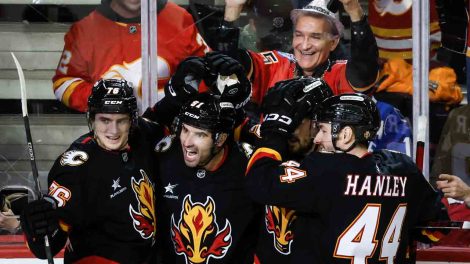Midway through last season the NHL began streamlining goalie equipment with a target on leg pads and pants. Rather than goalies being allowed to wear inflated equipment that had more to do with filling up the net than protecting the player, the NHL began to enforce “form-fitting” equipment that protects the goalies, while also opening up the net a little bit.
This season the target is on chest protectors and arm pads.
Rule 11.3 — Chest and Arm Pads — is 608 words long. It states, “The chest and arm protector worn by each goalkeeper must be anatomically proportional and size-specific based on the individual physical characteristics of that goalkeeper,” then gives precise measurements for elbow, arm, clavicle and shoulder protection.
Elbow floaters have been reduced from 7 inches to 6 across the front. Bicep and forearm pads must taper — 5.5 inches to 4.5, then 4.5 to 4. Clavicle floaters cannot extend more than 2 inches above the shoulder at the lateral edge, 1.5 inches at midpoint and 0.5 inches at the medial edge. Shoulder caps cannot project laterally beyond shoulders more than 1.5 inches.
To most eyes the change may not be noticeable, but you can bet goalies are keeping a close watch on it.
The hope is that, while goalies aren’t left vulnerable to injury, the little bit of extra room for shooters to look at in the net would lead to more goals. And though goals are up in the early part of the 2018-19 season, it’s only by a shade from the same point a year ago. It’s hard to gauge just how much the streamlined equipment is contributing to the rise in goals and how much of it is due to the changing game in front of the goalies. After all, scoring usually rises early in a season and falls off as it goes along.
Goals have been trending up and save percentages have been trending down four years in a row. In 2015-16 NHL teams combined to average 5.42 goals per game and that rose to 5.94 last season. In the early-goings in 2018-19 teams are averaging 6.18 goals per game. Through the first 56 games of the season we explored what aspects of this rise were sustainable based on recent historical comparisons.[sidebar]
Power plays are certainly contributing to this uptick, and Andrew Berkshire explored why a little more than a week ago. A total of 18 teams had a power-play success rate of at least 20 per cent last season, whereas in 2005-06 — the highest-scoring season of the salary cap era — only three teams cracked that mark. This year’s early average of 20.80 per cent on the power play is the highest level the NHL has seen since 1985-86.
So there are a number of factors contributing to the increase in goals, though we have to wonder just how much is directly related to the goalie equipment. It’s something they’re having to adapt to, but it’s been a long time coming.
As long as goals are up and goalies are being bruised, it will be a storyline to follow all season. Here we will gather what goalies around the league are saying about the new form-fitting gear.
[snippet ID=3322139]
ROBERTO LUONGO, FLORIDA PANTHERS
What he said: “So far I’ve been able to adjust to all the changes in the past — this one’s a bit tougher,” Luongo said Nov. 6 on Ice Surfing. “I think the protection is a little bit reduced and we are feeling the pucks more, especially in practice on our arms and stuff. I’m still trying to get used to it and make sure that I’m as safe as possible.”
What his stats are: 1-0-0, .957 SV%, 1.31 GAA
FREDERIK ANDERSEN, TORONTO MAPLE LEAFS
What he said: “I always like playing with a pretty beat-down chest protector to begin with, so I was always getting some stingers on the arms and shoulders once in a while. So I think for me, it hasn’t changed too much,” Andersen told Hockey Central at Noon on Wednesday. “I think a lot of guys, I don’t know if they forget how it felt before, but I think you still get some stingers once in a while and I don’t think you should jump to blaming the new gear yet. Granted, I haven’t seen what they’re wearing, obviously, but that’s my take on it.
“I think my experience with [NHL vice president of hockey operations Kay Whitmore] and the league has been good and pretty straightforward of trying to cut the shoulders a little bit and then making sure you’re still protected enough.”
What his stats are: 6-4-0, .919 SV%, 2.53 GAA
BRADEN HOLTBY, WASHINGTON CAPITALS
What he said: “Sooner or later someone’s going to get hurt pretty bad,” Holtby told the Associated Press. “You can deal with bumps and bruises and stuff. It’s when you hope someone doesn’t get a broken bone or some sort out of it. If they keep making things like that, they’re going to have to start monitoring the stick technology because guys shoot so hard right now we’ll have no choice but to be bigger.”
What his stats are: 4-2-1, .888 SV%, 3.41 GAA
JAMES REIMER, FLORIDA PANTHERS
What he said: “I’ve never flinched in my life,” Reimer told the AP. “I consider myself a tough guy. I’m from the country. I can take a few bruises here and there. But at what point? At what point is one guy going to let one loose and a guy’s going to break his arm?”
What his stats are: 1-3-1, .878 SV%, 3.41 GAA
SERGEI BOBROVSKY, COLUMBUS BLUE JACKETS
What he said: “No, it’s terrible actually,” Bobrovsky told the Columbus Dispatch on Oct. 17. “You start to be afraid of pucks, actually, especially in the practices. You get bruises in here (arms, elbows). It’s terrible.
“They cut (down) the arms, but basically they cut off the protection of the chest protector. That’s the bad thing. I’ve never had the bruises on my arms, but now it feels like every other shot goes there. If it goes there, it’s going to be sore.
“It’s all right if they want to make more goals or stuff like that, but when they cut out the protection from you, it’s a bad thing. It’s taking away little pieces (of focus), because in the practices, it’s human nature…if you go more and more there, every shot you get hit there, then your body and your mind (try) to protect your body — and then there is all those little hesitations. If you feel a little hesitation in your mind, it could cost you a goal.”
What his stats are: 2-4-0, .872 SV%, 3.87 GAA
BRIAN ELLIOTT, PHILADELPHIA FLYERS
What he said: “I’ve already sent a couple emails to Kay Whitmore,” Elliott told the Philadelphia Courier-Post on Oct. 8. “I’m getting bruised like crazy on my arms. I think that’s the biggest issue, they take away padding in the arms. It seems like every shot that you take that’s not clean on your blocker or in your glove, it’s leaving a mark.
“They wanted more ‘form fitting,’ but when you have more form fitting there’s no give. There’s no air between you and your pads, so the puck is hitting your pad and at the same time it’s hitting your bones and your flesh so there’s no cushion. It’s just straight shots to your arms and I don’t agree with it.”
What his stats are: 2-5-0, .886 SV%, 3.39 GAA
[relatedlinks]
CONNOR HELLEBUYCK, WINNIPEG JETS
What he said: “I’m getting bruises all over my arms. I’m pretty exposed in my shoulders,” Hellebuyck told the Winnipeg Free Press on Oct. 23.
“It’s definitely going to add a couple goals. We’re not talking big numbers. But it will add a couple goals and affect some save percentages. But that’s what the league wants. They want more goals, and they just gotta understand it’s going to reflect negatively on us.
“I still feel a little vulnerable in there. But it’s nothing I’m concerned or scared about. I’m more worried about the long term, if I’m finding spots that you don’t know about now. You never know when one might be the big injury and the bone break or something like that.”
What his stats are: 4-4-1, .907 SV%, 3.00 GAA
LAURENT BROSSOIT, WINNIPEG JETS
What he said: “It just kind of sucks that we end up being the guinea pigs, whereas you think you’d maybe try that out in other leagues before you get a finished product,” Brossoit said. “It was a rushed process in the summer. And that’s kind of what the issues are. A lot of guys didn’t get to try out their chest protector until, like, a week before camp. By that time, if you don’t want that one, you feel kind of trapped.”
Brossoit told the Free Press he eventually switched manufacturers and since then: “I haven’t had too many stingers. Maybe a couple in the arm.”
What his stats are: 3-0-0, .957 SV%, 1.67 GAA
HENRIK LUNDQVIST, NEW YORK RANGERS
What he said: “It was tight and hard to move and you got exposed in a couple areas where you had to talk to Kay (Whitmore) and make sure it was OK to cover your shoulders,” Lundqvist told AP. “I just made some adjustments just make sure it was exactly the way I wanted and the league wanted it, so it’s all good now.”
What his stats are: 2-6-1, .917 SV%, 2.77 GAA








